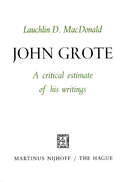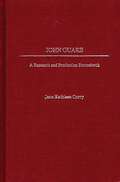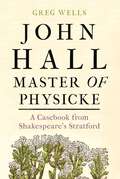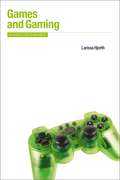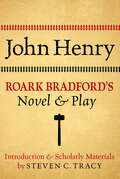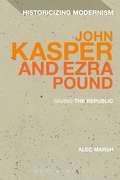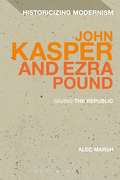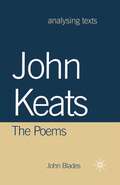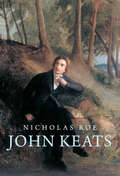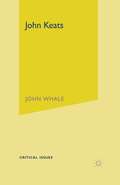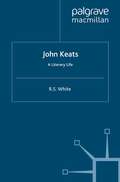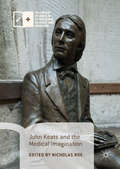- Table View
- List View
John Grisham: A Critical Companion (Critical Companions to Popular Contemporary Writers)
by Mary Beth PringleWith his seven legal thrillers, all published since 1989, John Grisham has won a huge following of readers and set a standard few contributors to the genre can match. Because of the success of his novels, the legal thriller is the most popular genre in American fiction today. In this study, Pringle explains how Grisham's legal thriller evolved from the thriller tradition and borrowed from the heroic romance novel, gothic novel, crime novel, and detective fiction. She shows how his novels examine contemporary social and legal problems that do not have simple solutions—ecology, ethnic relations, capital punishment, corporate greed, and health insurance—and how he depicts both the legal system and lawyers in their best and worst lights.Following a biographical chapter that focuses on Grisham's childhood in Arkansas, education, political career, and development as a writer, Pringle examines the legal thriller, its antecedents, and Grisham's contribution to the genre. An individual chapter is devoted to analysis of each of his novels. Each chapter synopsizes the novel, discusses its reception by critics, and features sections on plot development, character development, social/historical context and issues, and an alternative critical perspective from which to approach the novel, such as psychoanalytic theory or feminist criticism. The work includes a complete bibliography of Grisham's work, critical sources, and list of reviews of all of his novels. Because of Grisham's popularity with adults and young adults and the contemporary issues he raises, this study is valuable to students, book discussion group participants, and other interested readers, and is an essential purchase for school and public libraries.
John Grote: A Critical Estimate of his Writings
by Lauchlin D. MacDonaldAn objective of this book is to discuss some of the contributions made by John Grote to philosophy. This work is an extension of a dissertation written for the doctorate at Boston University. The author wishes to acknowledge the invaluable assistance in many places to Professor Peter A. Bertocci and the late Professor Edgar S. Brightman both of whom read the entire manuscript in its original form. Also, the author acknowledges the encouraging interest and support of his wife, Helen, whose many suggestions have improved the writing and without whose assistance this work would not have been accomplished. The author assumes complete responsibility for whatever errors or deficiencies appear in the book. All known writings of Grote are listed and the more important ones analyzed. LAUCHLIN D. MACDONALD CHAPTER I INTRODUCTION 1. JOHN GROTE'S LIFE i. Sketch of his life John Grote will remain best known by reason of the thought formu lated in the Exploratio Philosophica, or Rough Notes on Modern I ntellectu al Science. To the philosophical world of his own time he was well known as the teacher who ably held the chair of Moral Philosophy in the University of Cambridge from r855 until the year of his death, r866, to the Knightbridge Professor, William Whewell whose in succession Philosophy of Science is the subject of at least one chapter of the Exploratio Philosophica. Grote's birthplace was Beckenham in Kent, and the date, May 5, r8r3.
John Guare: A Research and Production Sourcebook (Modern Dramatists Research and Production Sourcebooks)
by Jane K. CurryBest known for his plays Six Degrees of Separation and The House of Blue Leaves, John Guare is a major figure in the contemporary American theater. Other notable works by Guare include Bosoms and Neglect, Landscape of the Body, and the Lydie Breeze series. His career began with off-off-Broadway experimentation in the sixties and continues through the present. In that time Guare has created many imaginative, eccentric plays that reflect the chaos, violence, and loneliness of life in our time. He frequently combines outrageous farce with painfully serious subject matter.This sourcebook is both a convenient reference and a resource for further investigation of Guare's works. The volume chronicles his achievements with a chronology and biographical essay. It also includes summaries of his published and unpublished plays, overviews of the critical reception of each work, production credits, a primary bibliography of dramatic and nondramatic writings, and extensive annotated bibliographies of reviews and other secondary material.
John Hall, Master of Physicke: A casebook from Shakespeare's Stratford
by Paul Edmondson Greg WellsThis is the first complete edition and English translation of John Hall’s Little Book of Cures, a fascinating medical casebook composed in Latin around 1634–5. John Hall (1575–1635) was Shakespeare’s son-in-law (Hall married Susanna Shakespeare in 1607), and based his medical practice in Stratford-upon-Avon. Readers have never before had access to a complete English translation of John Hall’s casebook, which contains fascinating details about his treatment of patients in and around Stratford. Until Wells’s edition, our knowledge of Hall and his practice has had to rely only on a partial, seventeenth-century edition (produced by James Cooke in 1657 and 1679, and re-printed with annotation by Joan Lane as recently as 1996). Cooke’s edition significantly misrepresents Hall by abridging his manuscript (Cooke removed Hall’s conversations with his patients), by errors of translation, and by combining Hall’s work with examples from Cooke’s own medical practice.
John Hall, Master of Physicke: A casebook from Shakespeare's Stratford
by Greg Wells Paul EdmondsonThis is the first complete edition and English translation of John Hall’s Little Book of Cures, a fascinating medical casebook composed in Latin around 1634–5. John Hall (1575–1635) was Shakespeare’s son-in-law (Hall married Susanna Shakespeare in 1607), and based his medical practice in Stratford-upon-Avon. Readers have never before had access to a complete English translation of John Hall’s casebook, which contains fascinating details about his treatment of patients in and around Stratford. Until Wells’s edition, our knowledge of Hall and his practice has had to rely only on a partial, seventeenth-century edition (produced by James Cooke in 1657 and 1679, and re-printed with annotation by Joan Lane as recently as 1996). Cooke’s edition significantly misrepresents Hall by abridging his manuscript (Cooke removed Hall’s conversations with his patients), by errors of translation, and by combining Hall’s work with examples from Cooke’s own medical practice.
John Henry Newman and the Imagination
by Bernard DiveFor John Henry Newman, religion is animated by an imaginative 'master vision' which 'supplies the mind with spiritual life and peace'. All his life, Newman reflected on this 'master vision'. His reflections on the moral imagination developed out of his understanding of practical wisdom, as characterized by Aristotle – the wisdom that 'the good man' has in living a good life. For Newman, the vision at the core of religion completes and perfects the intuitions of the conscience.John Henry Newman and the Imagination looks at how Newman's thinking about the moral and visionary imagination developed over the course of his life; it relates that thinking to his portrayals of religious experience, and vision, in his novels and his poetry. It presents fresh insights into the thought of one of the greatest visionaries of the Victorian age.
John Henry Newman and the Imagination
by Dr Bernard DiveFor John Henry Newman, religion is animated by an imaginative 'master vision' which 'supplies the mind with spiritual life and peace'. All his life, Newman reflected on this 'master vision'. His reflections on the moral imagination developed out of his understanding of practical wisdom, as characterized by Aristotle – the wisdom that 'the good man' has in living a good life. For Newman, the vision at the core of religion completes and perfects the intuitions of the conscience.John Henry Newman and the Imagination looks at how Newman's thinking about the moral and visionary imagination developed over the course of his life; it relates that thinking to his portrayals of religious experience, and vision, in his novels and his poetry. It presents fresh insights into the thought of one of the greatest visionaries of the Victorian age.
John Henry: Roark Bradford's Novel and Play
by Roark BradfordRoark Bradford's 1931 novel and 1939 play dealing with the legendary folk-hero John Henry (both titled John Henry) were extremely influential in their own time, but have since then been nearly forgotten. Steven C. Tracy has united these hard-to-find works in a single critical edition that helps contextualize-and revive-both texts. An expansive introduction explores Bradford's life; recounts critical responses to his works; and surveys John Henry's pervasive influence in folk, literary, and popular culture. The volume also features a wide array of supplementary materials including a selected bibliography and discography, transcriptions of folksong texts and recordings available during the 1930s, and a chronology of the lives of both Bradford and Henry. As Tracy's introduction makes clear, such a consideration of Bradford--set in the context of writers, both black and white, drawing upon African American folklore and using dialects along with stereotypical and non-stereotypical portrayals--is long overdue. This new edition is a windfall for scholars and students of folklore and African American literature.
John Heywood: Comedy and Survival in Tudor England
by Greg WalkerJohn Heywood was an important literary and theatrical pioneer in his own right, but he is also a revealing lens through which to view the wider tumultuous history of the sixteenth century. He was, through the period from the mid-1520s to the 1560s, as near to a celebrity as Tudor England possessed, famed for his 'merry' persona and good humour. But his public image concealed a deeper engagement with religious and political history. Enduringly resistant to extremism, he variously entertained, counselled, and cautioned his readers and audiences through four reigns, finding himself, as regimes changed and religious policies shifted, successively celebrated, marginalised, anathematised, condemned to death, recuperated, and celebrated once more before finally retreating into exile on the Continent in 1564. He produced plays at the courts of Henry VIII, Edward VI, Mary and Elizabeth, performed and taught keyboard music, wrote lyric poetry and songs, and from the mid-sixteenth century turned to collecting and publishing highly successful volumes of proverbs and epigrams for which he was remembered well into the seventeenth century. Each of these works provides a subtle, often courageously critical engagement with the politics of its moment. To study Heywood's career takes us beyond the clichés of popular history, beyond Shakespeare and the Elizabethan playhouses, beyond the canonical Henrician court poets and the writers of the Elizabethan 'Golden Age', beyond even the experiences of the century's chief ministers, intellectuals, and martyrs, to a theatrical and literary world less visible in the conventional sources. It opens a window on a culture in which the actions of monarchs, their councillors, and their victims were witnessed and reflected upon at one remove from the centres of power. And it allows us to re-examine the significance of an individual who deserves our attention, not only for his considerable artistic achievements, but also for the determination with which, often against the odds, he used his talents in pursuit of wider humanist cultural principles for over half a century.
John Heywood: Comedy and Survival in Tudor England
by Greg WalkerJohn Heywood was an important literary and theatrical pioneer in his own right, but he is also a revealing lens through which to view the wider tumultuous history of the sixteenth century. He was, through the period from the mid-1520s to the 1560s, as near to a celebrity as Tudor England possessed, famed for his 'merry' persona and good humour. But his public image concealed a deeper engagement with religious and political history. Enduringly resistant to extremism, he variously entertained, counselled, and cautioned his readers and audiences through four reigns, finding himself, as regimes changed and religious policies shifted, successively celebrated, marginalised, anathematised, condemned to death, recuperated, and celebrated once more before finally retreating into exile on the Continent in 1564. He produced plays at the courts of Henry VIII, Edward VI, Mary and Elizabeth, performed and taught keyboard music, wrote lyric poetry and songs, and from the mid-sixteenth century turned to collecting and publishing highly successful volumes of proverbs and epigrams for which he was remembered well into the seventeenth century. Each of these works provides a subtle, often courageously critical engagement with the politics of its moment. To study Heywood's career takes us beyond the clichés of popular history, beyond Shakespeare and the Elizabethan playhouses, beyond the canonical Henrician court poets and the writers of the Elizabethan 'Golden Age', beyond even the experiences of the century's chief ministers, intellectuals, and martyrs, to a theatrical and literary world less visible in the conventional sources. It opens a window on a culture in which the actions of monarchs, their councillors, and their victims were witnessed and reflected upon at one remove from the centres of power. And it allows us to re-examine the significance of an individual who deserves our attention, not only for his considerable artistic achievements, but also for the determination with which, often against the odds, he used his talents in pursuit of wider humanist cultural principles for over half a century.
John Irving: A Critical Companion (Critical Companions to Popular Contemporary Writers)
by Josie P. CampbellOne of America's most noted contemporary novelists, John Irving has created a body of fiction of extraordinary range, moving with ease from romance to fairytale to thriller. Although his fiction follows in the tradition of the great 19th-century world novelists, he is a quintessential American writer—his novels are laced with broad humor, farce, and absurd situations. He does not hesitate to tackle the troubling issues that have faced our nation in the past few decades, such as war, racism, sexism, abortion, violence, and AIDS. This study offers a clear, accessible reading of Irving's fiction. It analyzes in turn all of his novels from Setting Free the Bears (1968) to his newest novel A Widow for One Year (1998). It also provides the reader with a complete bibliography of Irving's fiction, as well as selected reviews and criticism.Following a biographical chapter on Irving's life, an overview of his fiction explores his work in light of his literary heritage and use of a variety of genres. Each of the following chapters examines an individual novel: Setting Free the Bears (1968), The Water-Method Man (1972), The 158-Pound Marriage (1973), The World According to Garp (1976), The Hotel New Hampshire (1981), The Cider House Rules (1985), A Prayer for Owen Meany (1989), A Son of the Circus (1994), and A Widow for One Year (1998). The discussion of each novel includes sections on plot and character development, thematic issues, and a new and fresh critical approach from which to read the novel. Campbell explores the great moral range in Irving's novels. She shows that all his novels deal with a character's quest to discover the self, a journey of raw energy that touches us because we recognize it as our own. This study will help readers to appreciate the experimental fiction that is Irving's trademark and his ability to capture the essence of American life in the last part of the twentieth century.
John Jakes: A Critical Companion (Critical Companions To Popular Contemporary Writers Ser.)
by Mary Ellen JonesJohn Jakes, often called the people's author and godfather of the historical novel, has made American history come to life in his series The Kent Family Chronicles and The North and South Trilogy. Through these novels, Jakes conveys the sweep of American history, both its glory and its grim scenes, from the American Revolution to the opening moments of the 20th century. Never glossing over the nation's flaws (slavery, materialism, a double-edged Manifest Destiny), Jakes nevertheless affirms American values. This is the first full-length critical study of his work. It examines in detail Jakes' 13 major novels to date and assesses his methods as America's history teacher. In Part I, following a chapter on Jakes' life, Jones examines the early novels and Jakes' use of the genres of historical fiction, the western, and the historical family sage. Part II, The Kent Family Chronicles, devotes an individual chapter to each of the novels in this series, The Bastard, The Rebels, The Seekers, The Furies, The Titans, The Warriors, The Lawless, and The Americans. Part III, New Beginnings, features chapters on North and South, Love and War, and Heaven and Hell, and chapters on California Gold and Homeland. The examination of each novel in this study includes sections on plot development, character development, and thematic issues. Jones also offers an alternative critical perspective from which to read each novelsuch as feminist literary criticism, New Historicism, Marxist criticism, and Deconstructionismthat gives the reader an alternative viewpoint from which to consider the novel. A complete bibliography of all of John Jakes' work, works about John Jakes, and a listing of reviews of all the novels examined in the book concludes the study.
John Kasper and Ezra Pound: Saving the Republic (Historicizing Modernism)
by Alec MarshJohn Kasper was a militant far-right activist who first came to prominence with his violent campaigns against desegregation in the Civil Rights era. Ezra Pound was the seminal figure in Anglo-American modernist literature and one of the most important poets of the 20th century. This is the first book to comprehensively explore the extensive correspondence - lasting over a decade and numbering hundreds of letters - between the two men. John Kasper and Ezra Pound examines the mutual influence the two men exerted on each other in Pound's later life: how John Kasper developed from a devotee of Pound's poetry to an active right-wing agitator; how Pound's own ideas about race and American politics developed in his discussions with Kasper and how this informed his later poetry. Shedding a disturbing new light on Ezra Pound's committed engagement with extreme right-wing politics in Civil Rights-era America, this is an essential read for students of 20th-century literature.
John Kasper and Ezra Pound: Saving the Republic (Historicizing Modernism)
by Alec MarshJohn Kasper was a militant far-right activist who first came to prominence with his violent campaigns against desegregation in the Civil Rights era. Ezra Pound was the seminal figure in Anglo-American modernist literature and one of the most important poets of the 20th century. This is the first book to comprehensively explore the extensive correspondence - lasting over a decade and numbering hundreds of letters - between the two men. John Kasper and Ezra Pound examines the mutual influence the two men exerted on each other in Pound's later life: how John Kasper developed from a devotee of Pound's poetry to an active right-wing agitator; how Pound's own ideas about race and American politics developed in his discussions with Kasper and how this informed his later poetry. Shedding a disturbing new light on Ezra Pound's committed engagement with extreme right-wing politics in Civil Rights-era America, this is an essential read for students of 20th-century literature.
John Keats (Analysing Texts)
by John BladesThis comprehensive guide to the poetry and letters of John Keats offers a highly readable and detailed textual analysis of the themes and techniques of his work. Blades assesses all the major writing - including the narratives and the great odes - and goes on to examine the context of the verse through a survey of the poet's letters and an examination of the key features of nineteenth century Romanticism. This lively and imaginative study concludes with a discussion of some of the most influential critical responses to Keats's work.
John Keats (Analysing Texts)
by John BladesThis comprehensive guide to the poetry and letters of John Keats offers a highly readable and detailed textual analysis of the themes and techniques of his work. Blades assesses all the major writing - including the narratives and the great odes - and goes on to examine the context of the verse through a survey of the poet's letters and an examination of the key features of nineteenth century Romanticism. This lively and imaginative study concludes with a discussion of some of the most influential critical responses to Keats's work.
John Keats: A New Life
by Nicholas RoeThis landmark biography of celebrated Romantic poet John Keats explodes entrenched conceptions of him as a delicate, overly sensitive, tragic figure. Instead, Nicholas Roe reveals the real flesh-and-blood poet: a passionate man driven by ambition but prey to doubt, suspicion, and jealousy; sure of his vocation while bitterly resentful of the obstacles that blighted his career; devoured by sexual desire and frustration; and in thrall to alcohol and opium. Through unparalleled original research, Roe arrives at a fascinating reassessment of Keats's entire life, from his early years at Keats's Livery Stables through his harrowing battle with tuberculosis and death at age 25. Zeroing in on crucial turning points, Roe finds in the locations of Keats's poems new keys to the nature of his imaginative quest.Roe is the first biographer to provide a full and fresh account of Keats's childhood in the City of London and how it shaped the would-be poet. The mysterious early death of Keats's father, his mother's too-swift remarriage, living in the shadow of the notorious madhouse Bedlam—all these affected Keats far more than has been previously understood. The author also sheds light on Keats's doomed passion for Fanny Brawne, his circle of brilliant friends, hitherto unknown City relatives, and much more. Filled with revelations and daring to ask new questions, this book now stands as the definitive volume on one of the most beloved poets of the English language.
John Keats: Reimagining History
by William A. UlmerThis book considers Keats’s major poems as exercises in Romantic historicism. The poetry’s rich allusiveness represents Keats’s effort to reclaim the British canon for Cockney revisionism, and reveals Keats characteristically invoking the past to define his contemporary cultural politics. The book begins by discussing Keats’s Cockney traditionalism in its Regency context and then proceeds through the poet’s career in chronological order. There are chapters on history and vocation in the poet’s first volume, the failed idealism of 'Endymion', gender and audience in the Medieval Romances, the 'Ode on a Grecian Urn' in historical context, secularism and consolation in the other great Odes, and then the two 'Hyperion' fragments, in which history ramifies beyond poetic method to become the explicit subject of inquiry. The result is a stimulating reassessment of Keats’s intellectual development and most admired poems.
John Keats: Reimagining History
by William A. UlmerThis book considers Keats’s major poems as exercises in Romantic historicism. The poetry’s rich allusiveness represents Keats’s effort to reclaim the British canon for Cockney revisionism, and reveals Keats characteristically invoking the past to define his contemporary cultural politics. The book begins by discussing Keats’s Cockney traditionalism in its Regency context and then proceeds through the poet’s career in chronological order. There are chapters on history and vocation in the poet’s first volume, the failed idealism of 'Endymion', gender and audience in the Medieval Romances, the 'Ode on a Grecian Urn' in historical context, secularism and consolation in the other great Odes, and then the two 'Hyperion' fragments, in which history ramifies beyond poetic method to become the explicit subject of inquiry. The result is a stimulating reassessment of Keats’s intellectual development and most admired poems.
John Keats (Critical Issues)
by John WhaleThis book offers an exciting reassessment of Keats with particular emphasis on gender identity and sexuality. Traditionally, Keats has been more readily associated with the 'feminine' than any other canonical male English poet. This feminization was always likely, given his tragically early death and the mythologizing which took place soon after. In contrast, John Whale explores Keats's writings from the perspective of masculinity and gender by placing them in the context of contemporary friendship groupings and coterie relationships. Whale addresses all the major poems and gives due prominence to the letters. In so doing, he offers a new understanding of Keats's exploration of poetry, gender and desire, and provides an extended analysis of Keats's quest for poetic fame in the face of the often conflicting forces of love and sexuality.Clear, concise and insightful, this is an essential guide to one of the best-known Romantic poets.
John Keats: A Literary Life (Literary Lives)
by R. WhiteAt the heart of this 'Literary Life' are fresh interpretations of Keats's most loved poems, alongside other neglected but rich poems. The readings are placed in the context of his letters to family and friends, his medical training, radical politics of the time, his love for Fanny Brawne, his coterie of literary figures and his tragic early death.
John Keats and Romantic Scotland
by Nicholas Roe Katie GarnerBetween 22 June and 18 August 1818, John Keats and his friend and collaborator Charles Armitage Brown embarked on an epic walking tour of the English Lake District, South West Scotland, Northern Ireland, the Ayrshire Burns Country, the Scottish Highlands and Western Isles, and the Great Glen north eastwards to Inverness, Beauly, the Black Isle, and Cromarty. During the tour, Keats and Brown both wrote extensive and detailed accounts of their experiences. The twelve new essays in this collection each explore the significance of the 1818 tour for understanding Keats's achievements, ranging across topics such as the contemporary Highland tour; Scottish literature, history, landscape and culture; Romantic responses to Robert Burns's life, works and places; and Keats's health and influence on Scottish artists.
John Keats and Romantic Scotland
Between 22 June and 18 August 1818, John Keats and his friend and collaborator Charles Armitage Brown embarked on an epic walking tour of the English Lake District, South West Scotland, Northern Ireland, the Ayrshire Burns Country, the Scottish Highlands and Western Isles, and the Great Glen north eastwards to Inverness, Beauly, the Black Isle, and Cromarty. During the tour, Keats and Brown both wrote extensive and detailed accounts of their experiences. The twelve new essays in this collection each explore the significance of the 1818 tour for understanding Keats's achievements, ranging across topics such as the contemporary Highland tour; Scottish literature, history, landscape and culture; Romantic responses to Robert Burns's life, works and places; and Keats's health and influence on Scottish artists.
John Keats and the Medical Imagination (Palgrave Studies in Literature, Science and Medicine)
by Nicholas RoeThis book presents ten new chapters on John Keats's medical imagination, beginning with his practical engagement with dissection and surgery, and the extraordinary poems he wrote during his 'busy time' at Guy's Hospital 1815-17. The Physical Society at Guy's and the demands of a medical career are explored, as are the lyrical spheres of botany, melancholia, and Keats's strange oxymoronic poetics of suspended animation. Here too are links between surveillance of patients at Bedlam and of inner city streets that were walked by the poet of 'To Autumn'. The book concludes with a survey of multiple romantic pathologies of that most Keatsian of diseases, pulmonary tuberculosis.


